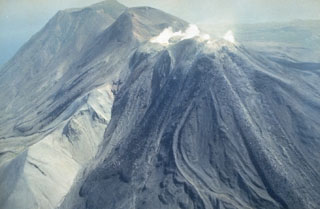Report on Moyorodake [Medvezhia] (Japan - administered by Russia) — 9 January-15 January 2013
Smithsonian Institution / US Geological Survey
Weekly Volcanic Activity Report, 9 January-15 January 2013
Managing Editor: Sally Sennert.
Please cite this report as:
Global Volcanism Program, 2013. Report on Moyorodake [Medvezhia] (Japan - administered by Russia) (Sennert, S, ed.). Weekly Volcanic Activity Report, 9 January-15 January 2013. Smithsonian Institution and US Geological Survey.
Moyorodake [Medvezhia]
Japan - administered by Russia
45.389°N, 148.838°E; summit elev. 1124 m
All times are local (unless otherwise noted)
SVERT reported that a thermal anomaly was detected over Kudriavy, a stratovolcano of the Medvezhia volcanic complex, on 11 January. Strong steam-and-gas plumes were also observed.
Geological Summary. The Moyorodake volcanic complex (also known as Medvezhia) occupies the NE end of Iturup (Etorofu) Island. Two overlapping calderas, 14 x 18 and 10 x 12 km in diameter, were formed during the Pleistocene. The caldera floor contains several lava domes, cinder cones and associated lava fields, and a small lake. Four small closely spaced stratovolcanoes were constructed along an E-W line on the eastern side of the complex. The easternmost and highest, Medvezhii, lies outside the western caldera, along the Pacific coast. Srednii, Tukap, and Kudriavy (Moyorodake) volcanoes lie immediately to the west. Historically active Moyorodake is younger than 2000 years; it and Tukap remain fumarolically active. The westernmost of the post-caldera cones, Menshoi Brat, is a large lava dome with flank scoria cones, one of which has produced a series of young lava flows up to 4.5 km long that reached Slavnoe Lake. Eruptions have been documented since the 18th century, although lava flows from cinder cones on the flanks of Menshoi Brat were also probably erupted within the past few centuries.

